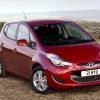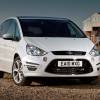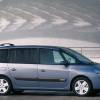
RAC sale – up to 33% off*
• Roadside cover from £5.29 a month†
• We get to most breakdowns in 60 mins or less
• Our patrols fix 4/5 breakdowns on the spot

By Jonathan Crouch
Introduction
Customers like the practicality of small MPV People Carriers but sales in this category fell off a cliff in the second part of the 21st century's second decade because small SUVs were perceived as being more charismatic. So what if you could produce a little MPV with the charisma of a little SUV? That was the thinking behind the much improved version of Fiat's 500L launched in 2017. Here, we check it out as a used buy.
Models
5dr small MPV (1.4 petrol, 1.3 MultiJet diesel, 1.6 MultiJet diesel [Pop, Pop Star, Urban, Mirror, Hey Google, 120th Anniversary, Lounge])
History
The Fiat 500 we all think of is the cheeky little three-door citycar that started this model's retro revolution back in 2008, but the brand always felt that this should be merely the starting rung on an ownership ladder designed to be fine for families as well as fashion-conscious urbanistas. A ladder encompassing seven seats and SUV styling, both of which were available with this model, the revised and considerably enhanced version of the spacious 500L small MPV launched in 2017.
Fiat's fame of course has traditionally been founded on much smaller cars than this - but in the 21st century, the brand knew that it needed to get better at being bigger if legions of owners of the 500 citycar were not to be lost to other makers as their needs and families grew. Hence the introduction of the original version of this 500L back in 2012, when it claimed to be the most space-efficient and personalisable design in the small MPV segment. Five years on though, a lot had changed though, with small SUVs like Fiat's own 500X by now usually preferred to little People Carriers like this one. So the question back in 2017 was whether there was still a place for the 500L in this changing market. Fiat thought there was.
To prove the point, the Italian brand thoroughly updated this car in mid-2017, changing 40% of all its components and in the process, creating the much improved model we're going to look at here. The previously rather awkward looks were developed to have more in common with the 500 citycar, media connectivity took a step forward and the cabin was of much higher quality. Just as importantly, this model offered three distinct identities: the standard 'Urban' version; the lengthened 7-seat 'Wagon' model; and the more rugged-looking 'Cross' variant with its higher ride height and enhanced traction system. All these changes weren't enough though and sales eventually trickled to a standstill in 2022.
What You Get
You tend to approach this 500L expecting it to be a pumped-up version of the 500 citycar - which of course it isn't. To make this model as big as it needed to be - fully 60cm longer and 18cm taller than an ordinary 500 - Andreas Wuppinger's styling team had to use a Punto supermini floorplan as the basis for something quite different. Then give the end result a recognisable '500'-style twist, hence the familiar wide-eyed front end. As for the changes made to this post-2017-era revised model, well they were mainly about creating more of a visual family connection between this car and the 500 city runabout that Fiat hoped many potential buyers would be graduating to it from. The uniquely-illuminated mid-level daytime running lights were, for example, borrowed from the then-recently improved version of that smaller car.
Inside, quite a few changes were made to this facelifted model to try and lift the rather limited showroom appeal that afflicted the cabin of the initial version of this car. The awful dished steering wheel of the original model was replaced by a much smarter circular-bezelled item and through it, you view a completely revamped instrument cluster with two round gauges either side of a neat 3.5-inch colour graphic display. Depending on preferences you can select via steering wheel buttons, this middle segment can brief you on route information, 'phone settings, audio selections, service intervals and trip computer read-outs, but you're most likely to simply leave it displaying a digital speedo. Perhaps the most significant cabin improvement though, lay in the centre of the fascia, with the addition of Fiat's next-generation 'Uconnect' infotainment system.
At the back, you ought to notice that this 500L is one of the longer supermini-based MPVs in its segment. Once inside, you'll find a rear cabin that sure enough, really does feel quite spacious by class standards, mainly because it offers more headroom than any other model in this part of the MPV segment. The lengthier 'Wagon' model extends its rear overhang by enough to allow the installation of a third seating row, though as you might expect, the two extra pews on offer are only really intended for young children.
And the boot? Well an MPV like this one based on supermini underpinnings is of course never going to be able to offer the size of cargo area you'd get in a much pricier family hatch-based Scenic or C-MAX-sector five-seat People Carrier from this era. Still, within the confines of the class, this 500L does pretty well, with 400-litres capacity on offer. It's a very usable space too, thanks to the standard so-called 'Cargo Magic Space' adjustable-height boot floor that you'll get providing you avoid entry-level trim. If you need more room, folding down the rear seatbacks frees up a 1,310-litre capacity in the five-seat variant - or up to 1,509-litres in the 'Wagon' model.
What You Pay
Please fill in the form here for an exact up-to-date information.
What to Look For
Our 500L ownership survey revealed more satisfied owners than we expected but there were still a few niggles. As in other Fiats, the Duologic auto gearbox doesn't get very favourable reviews, so try before you buy. We also came across issues relating to the radio, the stop start system and even the handbrake. Look out for potential issues with all of these things on your test drive.
Check for upholstery damage caused by child seats in the back, typical supermarket dints and scrapes, slipping clutches on the manual cars and ensure all the electrical functions - which can get surprisingly sophisticated on up-spec models - work as advertised as these can be expensive to fix. The 500L isn't bad on consumables like brake pads and most people should be able to park it without nerfing the extremities.
Replacement Parts
[based on 500L 1.4-litre petrol - 2018 - ex VAT] A set of front brake pads are around £13-£31; rears sit in the £80-£22 bracket. Front brake discs cost around £72; rears are in the £47 to £92 bracket. An air filter is in the £7 bracket. Oil filters cost from around £4. You'll pay from around £5 for a wiper blade. An alternator would be around £107. A starter motor would be priced in the £56 to £230 bracket. A timing belt's around £21.
On the Road
Potential 500L owners will come to this Fiat knowing it to be a more grown-up car than its citycar stablemate. They'll know that it won't be quite the same to drive. And of course it isn't, though you do get the light steering that marks that little tiddler out. This, in combination with great all-round visibility aided by the high, upright driving position, makes the 500L very much in its element around town. You really notice how much easier this car is to see out of when at junctions, helped by a clever A-pillar/front quarterlight design offering the same kind of curved windscreen look that characterised this car's spiritual predecessor, the Multipla model of the 1950s. It all adds to urban confidence marred only by ride quality that's a bit on the firm side - though it rarely gets uncomfortable. This, in short, is a car you might enjoy on the school run.
Beyond the city limits, the 500L feels much less assured. Here, you might wish that the steering offered you a little more feedback and that road and wind noise weren't quite so prominent. Under the bonnet, the range is based around either 95bhp or 120bhp petrol or diesel engine options. The green pump-fuelled powerplants are both 1.4-litres in size, with the 120bhp turbocharged T-Jet unit (only offered until 2018) infinitely superior to its feebler normally aspirated alternative. Most buyers though, will want one of the Multijet diesels. Either the 95bhp 1.3-litre unit (which comes with a Dualogc auto transmission option). Or the 120bhp 1.6-litre powerplant, (also only offered until 2018) which is capable of up to 67.3mpg on the combined cycle and 112g/km of CO2 (both NEDC figures). There are three 500L body style options - the standard 'Urban' model, the 7-seat 'Wagon' and the top SUV-style 'Cross' variant (only offered until 2018). 'Cross' buyers get a raised ride height and a 'Mode Selector' giving extra 'Traction+' and 'Gravity Control' driving settings for light off road use.
Overall
'Even more 500, even more convenient, even more technology'. That, according to Fiat, is what was on offer with this much improved post-2017-era 500L. It probably helps this Fiat's cause on the used market that the 500L is so quirky-looking. In our opinion though, the unusual aesthetics only start to work in its favour when you pay plenty to dress them up with the kind of up-market trim. Otherwise, the retro, stretched '500' model styling can just look rather odd. Get that right though and you might really like the way that fashionable thinking has been applied from a practical perspective here.
In summary, what we've got here - a little confusingly - is a little MPV that doesn't feel especially little, nor in some ways does it feel especially like an MPV. Fiat thought that was a good thing, here delivering us a compact, versatile and very individual contender able to take care of people and baggage-carrying chores with a practical dash of Italian flair. For them, this model was the 500 - all grown up. And a sensible family car you could really feel good about.







